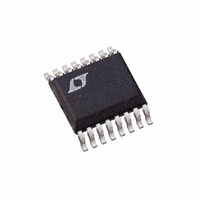LTC3703EGN Linear Technology, LTC3703EGN Datasheet - Page 18

LTC3703EGN
Manufacturer Part Number
LTC3703EGN
Description
IC BUCK/BOOST SYNC ADJ 5A 16SSOP
Manufacturer
Linear Technology
Type
Step-Down (Buck), Step-Up (Boost)r
Datasheet
1.LTC3703EGNPBF.pdf
(32 pages)
Specifications of LTC3703EGN
Internal Switch(s)
No
Synchronous Rectifier
Yes
Number Of Outputs
1
Voltage - Output
0.8 ~ 93 V
Current - Output
5A
Frequency - Switching
100kHz ~ 600kHz
Voltage - Input
9.3 ~ 100 V
Operating Temperature
-40°C ~ 85°C
Mounting Type
Surface Mount
Package / Case
16-SSOP
Lead Free Status / RoHS Status
Contains lead / RoHS non-compliant
Power - Output
-
Available stocks
Company
Part Number
Manufacturer
Quantity
Price
Company:
Part Number:
LTC3703EGN
Manufacturer:
LINEAR
Quantity:
4
Part Number:
LTC3703EGN
Manufacturer:
LTNEAR
Quantity:
20 000
Company:
Part Number:
LTC3703EGN#PBF
Manufacturer:
LT
Quantity:
3 291
Part Number:
LTC3703EGN#PBF
Manufacturer:
LINEAR/凌特
Quantity:
20 000
Company:
Part Number:
LTC3703EGN#TRPBF
Manufacturer:
LT
Quantity:
3 291
Part Number:
LTC3703EGN#TRPBF
Manufacturer:
LTNEAR
Quantity:
20 000
Company:
Part Number:
LTC3703EGN-5
Manufacturer:
LT
Quantity:
10 000
Part Number:
LTC3703EGN-5
Manufacturer:
LINEAR/凌特
Quantity:
20 000
Company:
Part Number:
LTC3703EGN-5#PBF
Manufacturer:
LT
Quantity:
320
Part Number:
LTC3703EGN-5#PBF
Manufacturer:
LINEAR/凌特
Quantity:
20 000
APPLICATIONS INFORMATION
LTC3703
Bottom MOSFET Source Supply (BGRTN)
The bottom gate driver, BG, switches from DRV
BGRTN where BGRTN can be a voltage between ground
and –5V. Why not just keep it simple and always connect
BGRTN to ground? In high voltage switching converters,
the switch node dV/dt can be many volts/ns, which will
pull up on the gate of the bottom MOSFET through its
Miller capacitance. If this Miller current, times the internal
gate resistance of the MOSFET plus the driver resistance,
exceeds the threshold of the FET, shoot-through will oc-
cur. By using a negative supply on BGRTN, the BG can be
pulled below ground when turning the bottom MOSFET off.
This provides a few extra volts of margin before the gate
reaches the turn-on threshold of the MOSFET. Be aware
that the maximum voltage difference between DRV
BGRTN is 15V. If, for example, V
voltage on DRV
Current Limit Programming
Programming current limit on the LTC3703 is straight
forward. The I
the maximum allowable voltage drop across the bottom
MOSFET. The voltage across the MOSFET is set by its on-
resistance and the current fl owing in the inductor, which
is the same as the output current. The LTC3703 current
limit circuit inverts the negative voltage across the MOSFET
before comparing it to the voltage at I
current limit to be set with a positive voltage.
To set the current limit, calculate the expected voltage
drop across the bottom MOSFET at the maximum desired
current and maximum junction temperature:
where δ is explained in the MOSFET Selection section.
V
internal 12μA pull-up and an external resistor:
The current limit value should be checked to ensure
that I
less than the maximum rated current of the inductor
and bottom MOSFET. The minimum value of current
limit generally occurs with the largest V
18
PROG
V
R
PROG
IMAX
LIMIT(MIN)
is then programmed at the I
= V
= (I
PROG
LIMIT
MAX
CC
> I
/12μA
)(R
pin is now 13V instead of 15V.
OUT(MAX)
pin sets the current limit by setting
DS(ON)
)(1 + δ)
and also that I
BGRTN
= –2V, the maximum
MAX
MAX
IN
pin using the
at the highest
, allowing the
LIMIT(MAX)
CC
CC
and
to
is
ambient temperature, conditions that cause the largest
power loss in the converter. Note that it is important to
check for self-consistency between the assumed MOSFET
junction temperature and the resulting value of I
heats the MOSFET switches.
Caution should be used when setting the current limit based
upon the R
limit is determined by the minimum MOSFET on-resistance.
Data sheets typically specify nominal and maximum values
for R
is that the minimum R
the typical value as the maximum lies above it. Consult the
MOSFET manufacturer for further guidelines.
For best results, use a V
500mV. Values outside of this range may give less accurate
current limit. The current limit can also be disabled by
fl oating the I
FEEDBACK LOOP/COMPENSATION
Feedback Loop Types
In a typical LTC3703 circuit, the feedback loop consists of
the modulator, the external inductor, the output capacitor
and the feedback amplifi er with its compensation network.
All of these components affect loop behavior and must be
accounted for in the loop compensation. The modulator
consists of the internal PWM generator, the output MOSFET
drivers and the external MOSFETs themselves. From a
feedback loop point of view, it looks like a linear voltage
transfer function from COMP to SW and has a gain roughly
equal to the input voltage. It has fairly benign AC behavior
at typical loop compensation frequencies with signifi cant
phase shift appearing at half the switching frequency.
The external inductor/output capacitor combination
makes a more signifi cant contribution to loop behavior.
These components cause a second order LC roll off at the
output, with the attendant 180° phase shift. This rolloff is
what fi lters the PWM waveform, resulting in the desired
DC output voltage, but the phase shift complicates the
loop compensation if the gain is still higher than unity
at the pole frequency. Eventually (usually well above the
LC pole frequency), the reactance of the output capacitor
DS(ON)
DS(ON)
, but not a minimum. A reasonable assumption
MAX
pin.
of the MOSFETs. The maximum current
DS(ON)
PROG
voltage between 100mV and
lies the same amount below
LIMIT
which
3703fb













